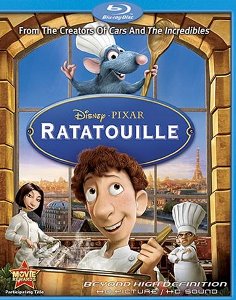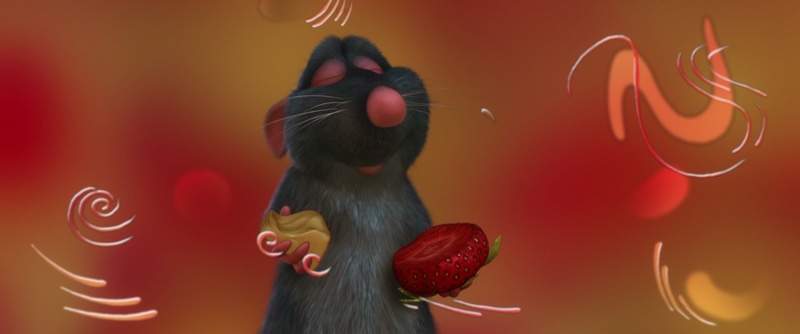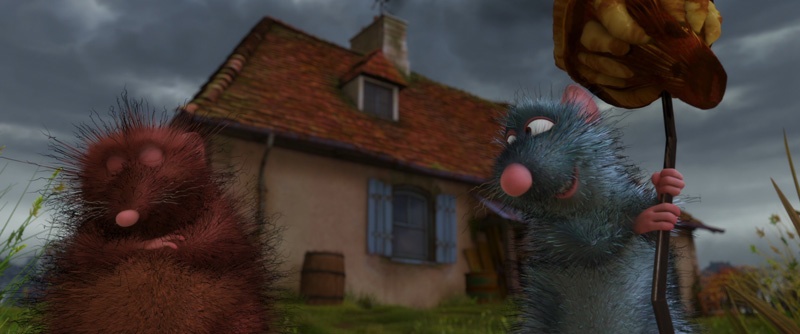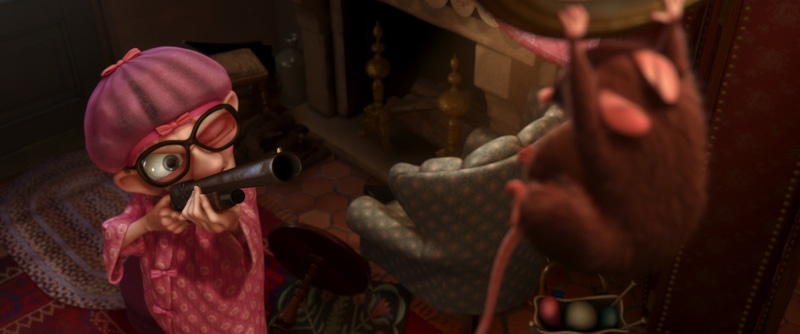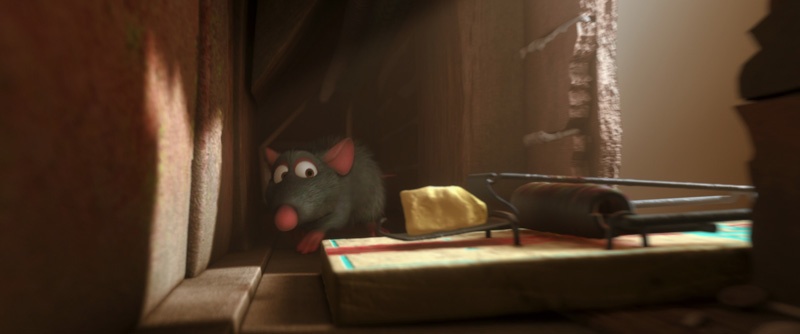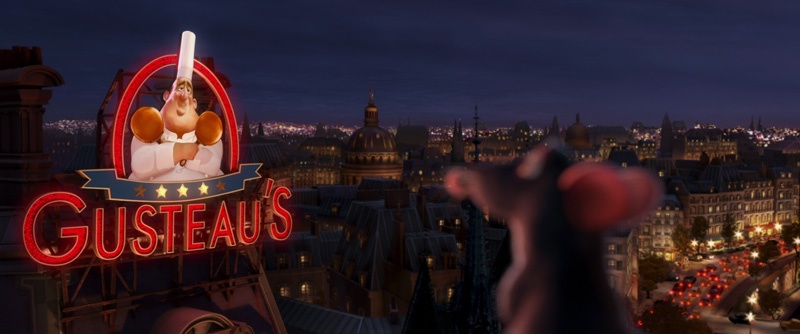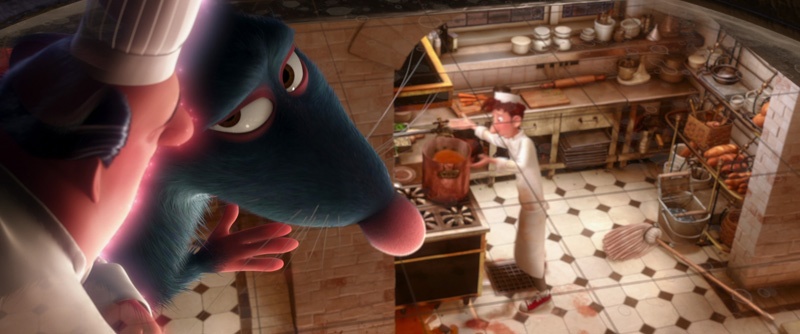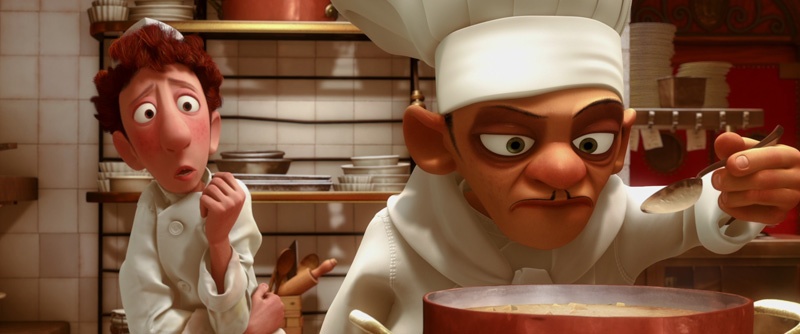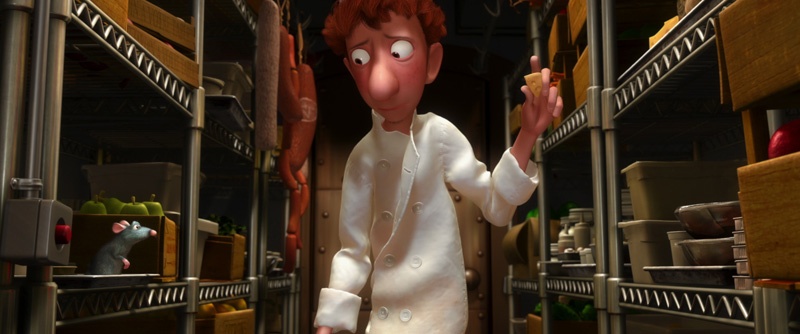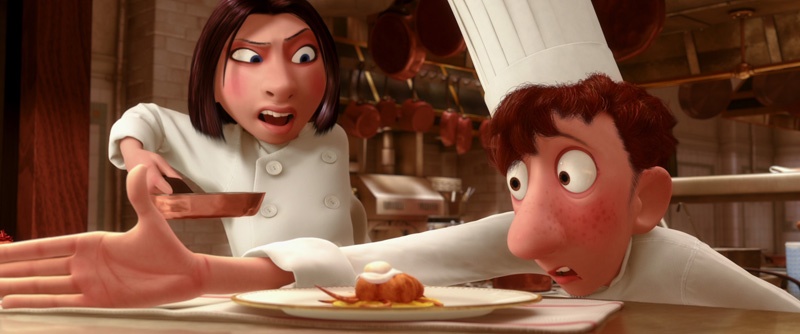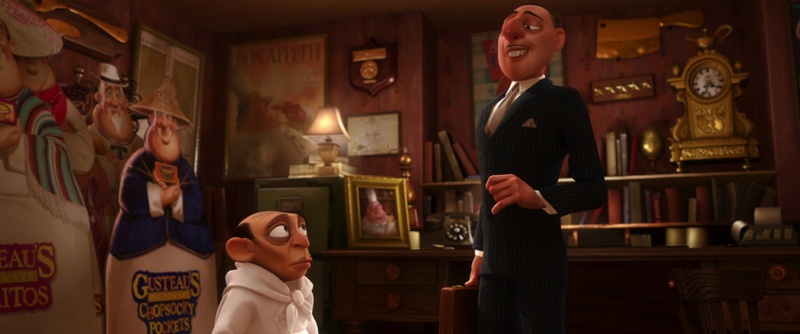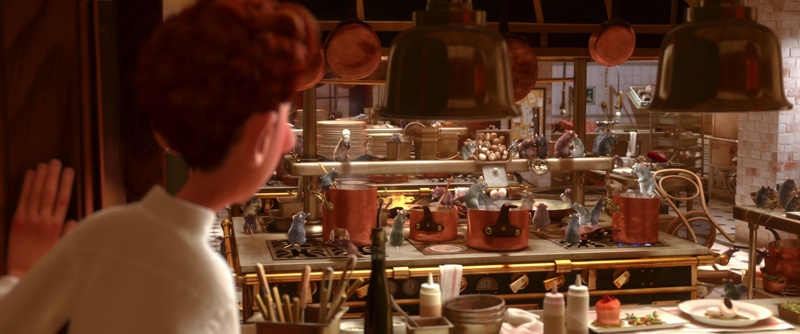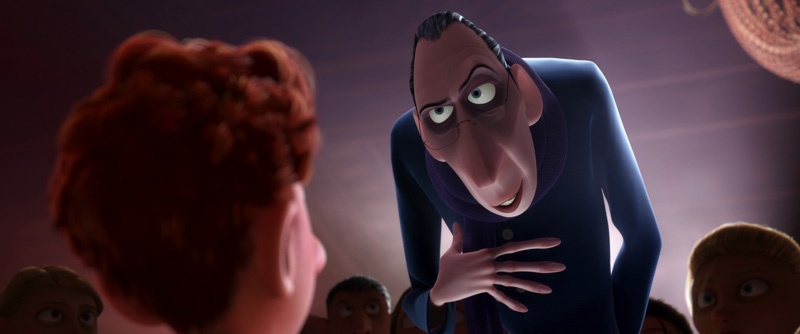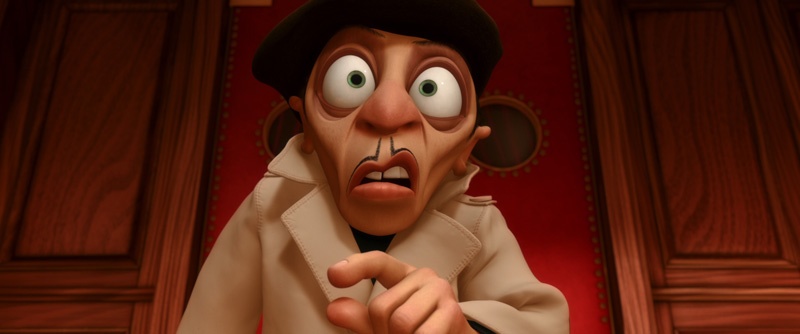Ratatouille - [Blu-ray]
(Brad Bird, 2007)
Studio: Pixar Animation / Walt Disney Studios Home Entertainment (USA)
Disc:
Region: 'A'-locked (as verified by the Momitsu region FREE Blu-ray player)
Runtime: 1:41:47.559
Disc Size: 48,306,908,370 bytes
Feature Size: 28,606,593,024 bytes
Video Bitrate: 23.42 Mbps
Chapters: 31
Case: Standard Blu-ray case
Release date: November 6th, 2007
Video:
Aspect ratio: 2.39:1
Resolution: 1080p / 23.976 fps
Video codec: MPEG-4 AVC Video
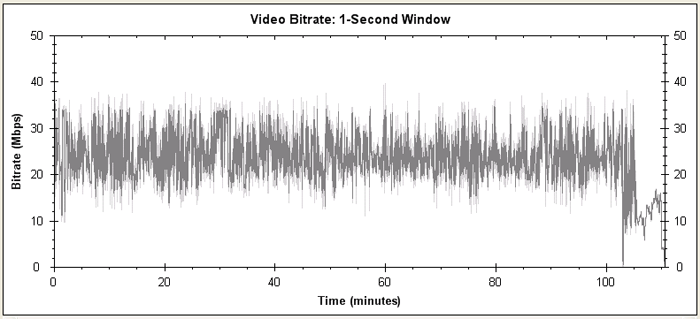 |
Audio:
LPCM Audio English 6912 kbps 5.1 / 48 kHz / 6912 kbps / 24-bit
Dolby Digital EX Audio English 640 kbps 5.1-EX / 48 kHz / 640 kbps
Dolby Digital EX Audio French 640 kbps 5.1-EX / 48 kHz / 640 kbps
Dolby Digital EX Audio Spanish 640 kbps 5.1-EX / 48 kHz / 640 kbps
Dolby Digital Audio English 192 kbps 2.0 / 48 kHz / 192 kbps
Subtitles:
English SDH, French, Spanish, none
Extras
• Cine-Explore (an in-movie behind-the-scenes interactive experience)
• Fine Food & Film Feature with director Brad Bird & chef Thomas Keller
• Gusteau's Gourmet Video Game
• New Animated Short with Remy & Emile: Your Friend The Rat
• Animated Short: Lifted
• Deleted Scenes
32 chapters
Standard Blu-ray case w/slipcover
1 disc: 50GB single layer
Release Date: November 6th, 2007
Ratatouille ~ Comment
Ratatouille was the first movie I had ever seen prior to its theatrical release, even before a "sneak preview". The unique benefit of this was that I was uninfluenced by the "buzz'" of published reviews or water cooler and Internet gossip. True, I did see the film at Pixar in their totally awesome theatre, but somehow my experience of the movie seemed detached from the venue in a way I did not anticipate. Perhaps it was the audience – simultaneously and understandably appreciative of their own work yet critical of it. Or perhaps it was the unique reality of the theatre itself: I've never sat so close to a screen with an image that took so much of my field of view, yet so dense there was never a question of resolution.
Sure, I talked about the film briefly afterward with my friends, one of whom is a software designer at Pixar. But still, I remained curiously disconnected from the critical process – almost as if I needed comment elsewhere in order to clarify my own understanding. This revelation did not come as a surprise to me as it illuminated something I've always suspected about my own personality, Still, it was bit unsettling. I resolved to not even try to formulate a critique until I saw the film on its DVD release – so here we are. I saw Ratatouille for the second time only last night, some five months after that fateful evening at Pixar.
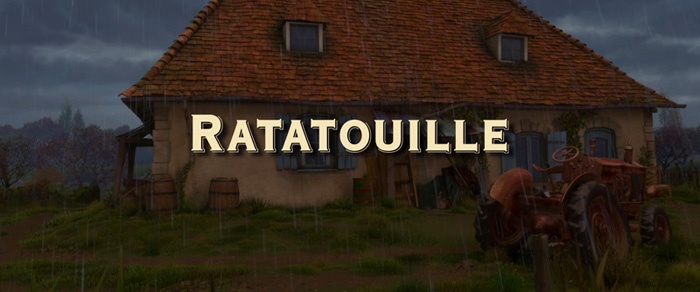 |
Have you ever tried to pinpoint exactly what makes a Pixar film different from other animated movies? They are different, are they not? Different, not only from early and late Disney, but from Dreamworks, Blue Sky or any other computer animated film company. For me, that difference can be summed up in one word: texture. Not only the texture of its image, but the texture of its text, the voicing, and the music. Pixar films are multi-dimensional in so many ways. They are a wedding cake of every imaginable flavor and density, yet all belonging to the same cake. They never sit still. Visual and narrative movement is dynamic and musical. John Lasseter says that everything develops from the story. And, except for Cars, which got a little sidetracked, we can see how that is so.
One of the most engaging things about a Pixar feature film is how it manages to appeal to audiences of such a broad range – and yet never seems to pander to one at the expense of another. This is why there is no bathroom humor in a Pixar film. No farting. Pixar has decided it is not necessary to appeal to that level of childishness in us in order to keep our attention – a decision that, no doubt, keeps their movies lagging behind the Shreks of the world in the marketplace, despite more favorable critical response.
Ratatouille – a word which I am getting really good at typing – is directed by Brad Bird, whose first work for Pixar was the very incredible, The Incredibles. Bird entered the world of animated feature films fully grown with The Iron Giant, which he did for Warner Bros Animation in 1999. In terms of pacing, Ratatouille is somewhere in between, but in terms of density of color and texture, it clearly shows what the environment at Pixar can do for a fellow. There isn't a single frame of Ratatouille with dead air, anywhere. Co-directing credit is shared with Jan Pinkava, whose claim to fame so far is the Oscar winning short, Geri's Game. And, have I mentioned "subtle" as another important Pixar trademark: Remy is one small rat, but do our humble directors compensate by having him yell and contort beyond his ken. Remy's little shrug when Linguini asks him if he's the cook is worth the price of admission.
As long as I'm on "subtle", this is as good a point as any to point out Pixar's avoidance of BIG NAME vocal talent. I remember the posters for Robots, where Ewan McGregor and the robot were promoted as one and the same person. It's not that Pixar will bypass a name where it is felt they are the right acting voice for the job – let us now give thanks for the appearance of Peter O'Toole as the acerbic critic, Anton Ego – but they don't seem to make a thing of it. The vocal characterizations in Ratatouille are spot on: Lou Romano, whose name looks familiar but probably isn't, is boyish embarrassment personified; Janeane Garofalo is cutting edge as Linguini's co-chef and love interest; and the redoubtable Ian Holm as the insidious Skinner.
There is a Proustian moment near the end of Ratatouille – and where else but in a Pixar movie could we even be thinking about Proust - where a food critic bites into a morsel of ratatouille and is instantly transported to his childhood. It's a moment that is so Pixar because it is both literary, and thus appeals to those of us who have even a passing knowledge of Proust, and fundamental to the human experience for anyone with eyes to see or a memory of something fleeting – a smell, a sight, a name - that suddenly takes them back to a moment of their youth.
Ratatouille ~ The Score Card
The Movie : 9
Remy (voiced by stand-up comic, Patton Oswalt) is one discriminating rat. That's both the good news and the bad for a creature who sees himself both as part of his pack and separate from it. He chides his brother, Emile, about the garbage he puts into his mouth. It's a "you are what you eat" sort of scenario. Remy, it seems, is a gourmet with longings to be a cook – and as plots will have their way, he soon finds himself in the kitchen of Paris' once famed Gusteau's. There he strikes up an unholy alliance with the garbage boy - did I mention that "irony" was Pixar's middle name – for the boy, Alfredo Linguini, to front for Remy while the rat pulls the strings, as it were. The soup thickens as the insanely jealous and conniving head chef, Skinner who has devolved Gusteau's into the world of frozen microwavable food products – yuk! – learns that Linguini (unbeknownst even to him) is the son of Gusteau himself and is in line to inherit. Meanwhile a difficult romance is budding between the clumsy Linguini and the experienced chef, Colette.
Image : 9 (9/9.5)
NOTE: The below Blu-ray captures were taken directly from the Blu-ray disc.
The score of 9 indicates a relative level of excellence compared to other Blu-ray DVDs. The score in parentheses represents: first, a value for the image in absolute terms; and, second, how that image compares to what I believe is the current best we can expect in the theatre. What we have here is a picture that passes all the usual tests for clarity, cleanliness and freedom from artifacts.
We would expect a digitally derived image to score big on Blu-ray, and so it does, though I thought it was bit soft overall – that may have been intentional. I'm embarrassed to say that I forgot. It may be only that my projector needs just a skosh more tweaking, but I felt that the whites of linen jackets blew out a little quickly compared to me memory from the Pixar theatre. Textures, surfaces, shading, color purity, movement, expression is all there. The further you are into the movie, the more respect you will have for its wonders.
CLICK EACH BLU-RAY CAPTURE TO SEE ALL IMAGES IN FULL 1920X1080 RESOLUTION
Audio & Music : 10/8
Unlike Cars, which requires a slam/bang audio mix, Ratatouille requires only subtlety. There are so many audio textures it's hard to count them; but everything from light-footed scampering across a kitchen floor - as opposed to a stovetop, as differentiated from a drainpipe, as contrasted with traveling across versus up or down – to a lightning strike, to an underground waterfall, to sauces simmering or oil frying, are all exquisitely rendered. Michael Giacchino's original music – he's done quite a lot of work for TV as well as for The Incredibles and is not Randy Newman this time, good call, there - is just the right masala of quasi-Parisian kitsch, romantic lushness and mid-20th century jazz to be served with such an understated movie.
Operations : 9
It may be that the idea of two main menus existed for the Blu-ray edition of Cars, but that it escaped me; but as if Disney heard my pleas, they have come up with this altogether awesome way of solving the problem: namely to make it clear that you can get to the movie, the shorts and the video from the first main menu, but if you want a detailed version, from which you can leave and return anywhere with impunity, then there's that option as well. And what an option – though I fear it may be daunting for folks with smallish screens, since the font is quite small. That said, I recommend you go to Play Movie first, because it takes just as long to load, and from there you can get directly and immediately to the big Total Menu, where we discover a number of really cool things: the first is that the movie proceeds in real time in a PIP. The second is that the movie is automatically put on Pause while you sort out whatever extra features you wish to explore, including Cine-Explore (which in this regard works differently from Cars). Not so new maybe, but number three is: If you press "menu" on your remote while in any extra feature, a sidebar appears to give you options to return to the film or to the main menu. What's more, when you activate Scene Selection, not only are the chapters titled, but a thumbnail appears while the feature keeps running in PIP. How often do you see that!
Extras : 8
The supplements in the Cine-Explore function (which operate differently from Cars), are a tour-de-force of production-making, and take the place of the feature film while it remains on pause. These are of mixed resolutions and aspect ratios, but none are low-fi.
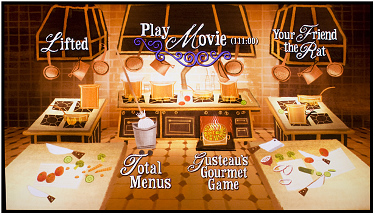 |
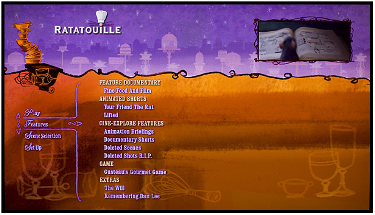 |
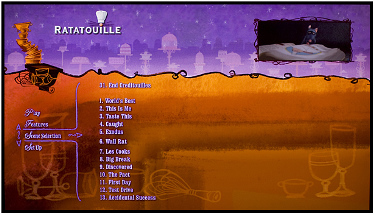 |
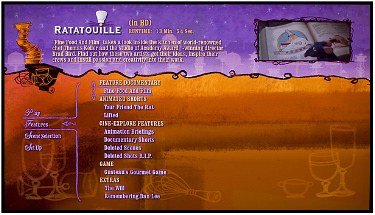 |
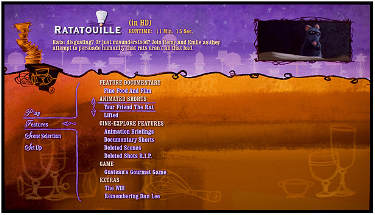 |
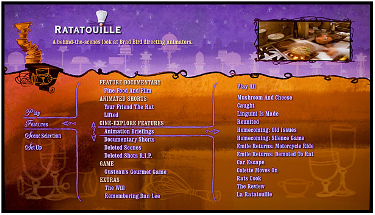 |
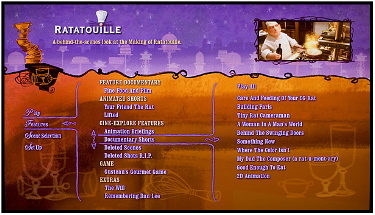 |
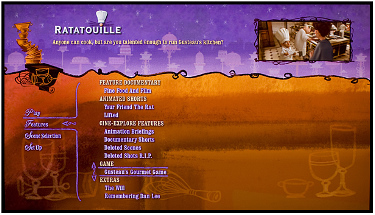 |
|
|
|
Recommendation: 10
Not as laugh-out-loud as The Incredibles or Toy Story, but this one has substance to start and grows on you with repeated viewings.
Leonard Norwitz
LensViews
November 9th, 2007
May 2010

